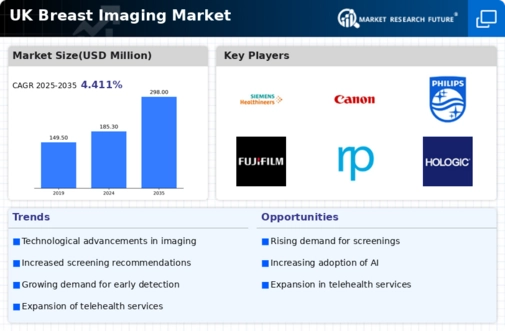Patient-Centric Care Models
The shift towards patient-centric care models is influencing the breast imaging market in the UK. Healthcare providers are increasingly focusing on personalized treatment plans and patient engagement, which necessitates the use of advanced imaging technologies. This approach emphasizes the importance of understanding individual patient needs and preferences, leading to tailored screening protocols. The breast imaging market is adapting to this trend by offering more comprehensive imaging services that align with patient expectations. Enhanced communication and education about imaging procedures are also becoming integral to the patient experience. As providers strive to improve patient satisfaction and outcomes, the demand for innovative imaging solutions that support these models is likely to grow, thereby driving market expansion.
Rising Incidence of Breast Cancer
The increasing incidence of breast cancer in the UK is a primary driver for the breast imaging market. According to recent statistics, approximately 55,000 new cases are diagnosed annually, leading to heightened demand for effective screening and diagnostic tools. This trend underscores the necessity for advanced imaging technologies, as early detection significantly improves treatment outcomes. The breast imaging market is responding to this need by innovating and expanding its offerings, including digital mammography and MRI technologies. As awareness of breast cancer risks grows, healthcare providers are likely to invest more in imaging solutions, further propelling market growth. The focus on early detection and preventive care is expected to drive the adoption of breast imaging technologies, making them essential components of breast cancer management in the UK.
Government Initiatives and Funding
Government initiatives aimed at improving breast cancer detection and treatment are significantly influencing the breast imaging market. The UK government has allocated substantial funding to enhance screening programs, which has resulted in increased access to advanced imaging technologies. For instance, the NHS Breast Screening Programme has been instrumental in promoting regular screenings for women aged 50 to 70, thereby increasing the demand for mammography services. This funding not only supports the acquisition of state-of-the-art imaging equipment but also facilitates training for healthcare professionals. As a result, the breast imaging market is likely to experience growth driven by these initiatives, which aim to reduce mortality rates and improve patient outcomes through timely diagnosis and intervention.
Aging Population and Healthcare Demand
The aging population in the UK is a significant driver of the breast imaging market. As the demographic shifts towards an older population, the incidence of breast cancer is expected to rise, necessitating increased screening and diagnostic services. Women aged 50 and above are at a higher risk, and this demographic is projected to grow substantially in the coming years. Consequently, the breast imaging market must prepare for a surge in demand for imaging services tailored to this age group. This may involve expanding screening programs and investing in more advanced imaging technologies to accommodate the needs of older patients. The interplay between an aging population and the demand for effective breast cancer detection is likely to shape the future landscape of the breast imaging market.
Technological Integration in Healthcare
The integration of advanced technologies in healthcare is reshaping the breast imaging market. Innovations such as artificial intelligence (AI) and machine learning are being increasingly adopted to enhance diagnostic accuracy and efficiency. AI algorithms can assist radiologists in identifying abnormalities in mammograms, potentially increasing detection rates by up to 30%. This technological evolution is not only improving patient outcomes but also streamlining workflows in imaging departments. The breast imaging market is witnessing a shift towards more automated and precise imaging solutions, which could lead to reduced operational costs and improved patient throughput. As healthcare providers seek to leverage these technologies, the demand for sophisticated imaging systems is expected to rise, further driving market growth.





















Leave a Comment